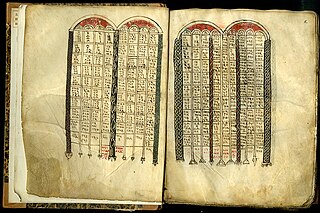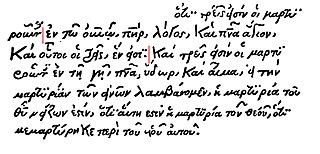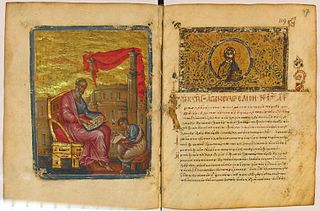
The Codex Vaticanus, designated by siglum B or 03, δ 1, is a Christian manuscript of a Greek Bible, containing the majority of the Greek Old Testament and the majority of the Greek New Testament. It is one of the four great uncial codices. Along with Codex Alexandrinus and Codex Sinaiticus, it is one of the earliest and most complete manuscripts of the Bible. Using the study of comparative writing styles (palaeography), it has been dated to the 4th century.

Codex Koridethi, also named Codex Coridethianus, designated by siglum Θ or 038, ε050, is a Greek uncial manuscript of the New Testament, written on parchment. Using the study of comparative writing styles (palaeography), it has been assigned to the 9th century CE. The manuscript has several gaps.

Codex Washingtonianus, Codex Washingtonensis, Codex Freerianus, also called the Washington Manuscript of the Gospels, The Freer Gospel and The Freer Codex, is a Greek uncial manuscript of the four Gospels, written on parchment. It is designated by W or 032 in the Gregory-Aland numbering of New Testament manuscripts, and ε014 in the von Soden numbering of New Testament manuscripts. Using the study of comparative writing styles (palaeography), it has been dated to the 4th or 5th century. The manuscript has some gaps. The manuscript was among a collection of manuscripts bought by American industrialist Charles Lang Freer at the start of the 20th century, and first published by biblical scholar Henry A. Sanders.

Uncial 030, designated by siglum U or 030, ε 90, is a Greek uncial manuscript of the New Testament on parchment, dated palaeographically to the 9th century. The manuscript has complex contents, with full marginalia.

Codex Cyprius, designated by Ke or 017, ε71, or Codex Colbertinus 5149, is a Greek uncial manuscript of the four Gospels, written on parchment. It is one of the few uncial manuscripts with the complete text of the four Gospels, and it is one of the more important late uncial manuscripts. It was brought from Cyprus to Paris.

Codex Sangallensis is a Greek-Latin diglot uncial manuscript of the four Gospels. It is designated by Δ or 037 in the Gregory-Aland numbering of New Testament manuscripts, and ε76 in the von Soden numbering of New Testament manuscripts. Using the study of comparative writing styles (palaeography), it is usually dated to the 9th century CE, though a few palaeographers would place it in the 10th century CE. It was given its current name by biblical scholar Johann Martin Augustin Scholz in 1830.

Codex Tischendorfianus III – designated by siglum Λ or 039, ε 77 – is a Greek uncial manuscript of the Gospels on parchment. Palaeographically it has been assigned to the 9th or 10th century.
Codex Vaticanus Graecus 2061, usually known as Uncial 048, α1 (Soden), is a Greek uncial manuscript on parchment. It contains some parts of the New Testament, homilies of several authors, and Strabo's Geographica. Formerly it was known also as the Codex Basilianus 100, earlier as Codex Patriniensis 27. It was designated by ב a, p.

Codex Basilensis A. N. IV. 2 is a Greek minuscule manuscript of the entire New Testament, apart from the Book of Revelation. Using the study of comparative writings styles (palaeography), it is usually dated to the 12th century CE. It is known as Minuscule 1, δ 254, and formerly designated by 1eap to distinguish it from minuscule 1rK.
Codex Basilensis A. N. IV. 4, known as Minuscule 2815, α 253 (Soden), formerly labelled as 2ap in all catalogues, but subsequently renumbered by Aland, is a Greek minuscule manuscript of the New Testament, dated paleographically to the 12th century.

Codex Montfortianus designated by 61, δ 603, and known as Minuscule 61 is a Greek minuscule manuscript of the New Testament on paper. Erasmus named it Codex Britannicus. Its completion is dated on the basis of its textual affinities to no earlier than the second decade of the 16th century, though a 15th-century date is possible on palaeographic grounds. The manuscript is famous for including a unique version of the Comma Johanneum. It has marginalia.

Minuscule 700, ε 133, is a Greek New Testament minuscule manuscript of the Gospels, written on parchment. It was formerly labelled as 604 in all New Testament manuscript lists, however textual critic Caspar René Gregory gave it the number 700. Using the study of comparative writing styles (palaeography), it has been dated to the 11th century. It is currently housed at the British Library in London.

Minuscule 1739, α 78, is a Greek minuscule manuscript of the New Testament made of parchment. Using the study of comparative writing styles (palaeography), it is dated to the 10th century.
Codex Ephesinus, minuscule 71, ε 253, is a Greek minuscule manuscript of the New Testament, on parchment, illuminated, and elegantly written. It is dated by the colophon to 1160. In the 15th century the manuscript was prepared for liturgical use. The scribal errors are not numerous, but it has many textual divergences from the common text. The Greek text of the codex is a representative of the Byzantine text-type, but the textual character of the codex is disputed by scholars since the 19th century.
Minuscule 225, ε 1210, is a Greek minuscule manuscript of the New Testament, written on parchment. A colophon dates it to the year 1192. It was adapted for liturgical use.

Minuscule 330, δ 259 (Soden), is a Greek minuscule manuscript of the New Testament, on parchment. Palaeographically it has been assigned to the 12th century. It has marginalia. The Greek text of the codex is a representative of the Byzantine text-type.
Minuscule 365, δ 367 (Soden), is a Greek minuscule manuscript of the New Testament with some parts of the Old Testament, on parchment. Paleographically it has been assigned to the 12th century. It has marginalia.
Minuscule 460, α 397, is a Greek-Latin-Arabic minuscule manuscript of the New Testament, on parchment. The manuscript is lacunose. Palaeographically it has been assigned to the 13th century. Formerly it was labelled by 96a and 109p.

Minuscule 543, ε 257 and labelled 556 by biblical scholar and textual critic F. H. A. Scrivener, is a Greek minuscule manuscript of the New Testament, written on parchment. Using the study of comparative handwriting styles (palaeography) it has been assigned to the 12th century.
Ernest Cadman Colwell was an American biblical scholar, textual critic and palaeographer.














